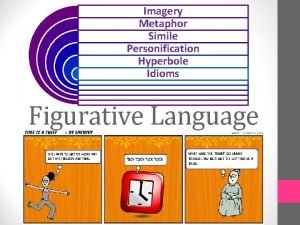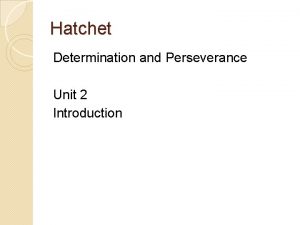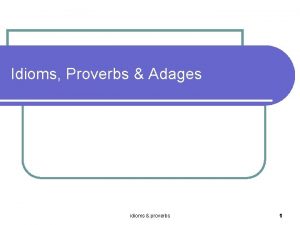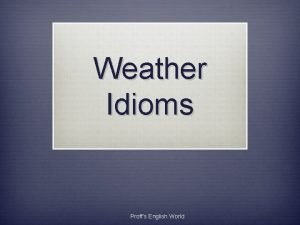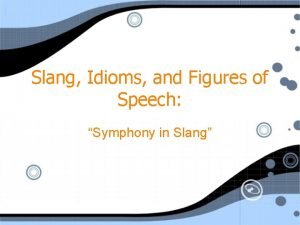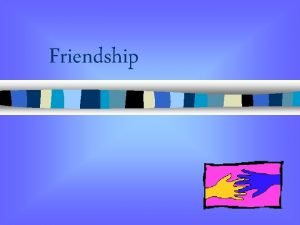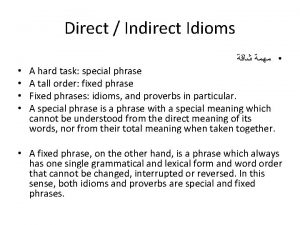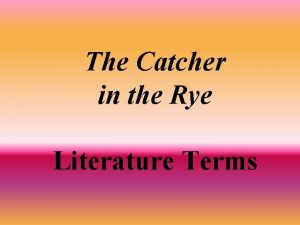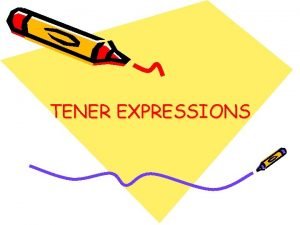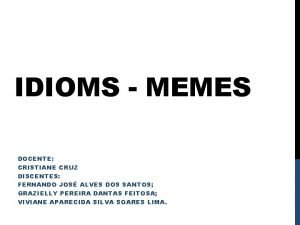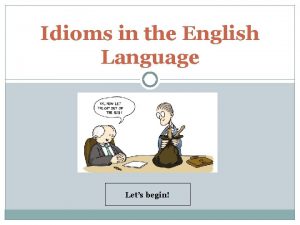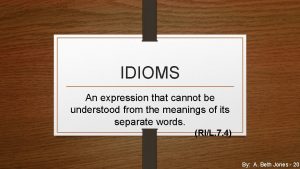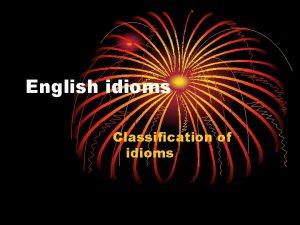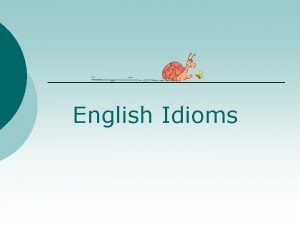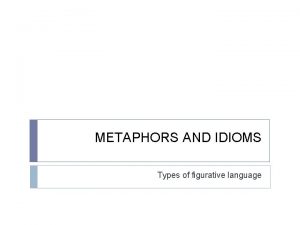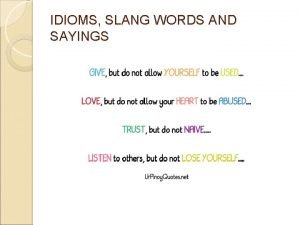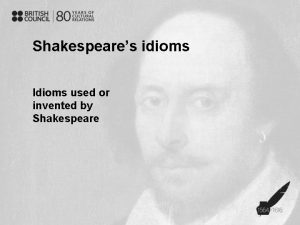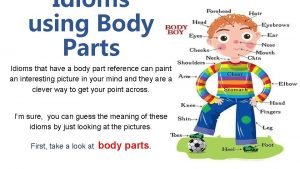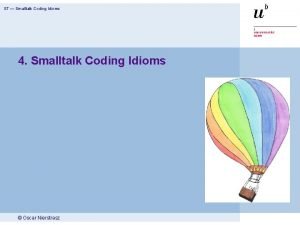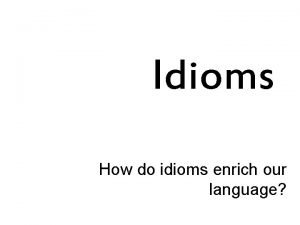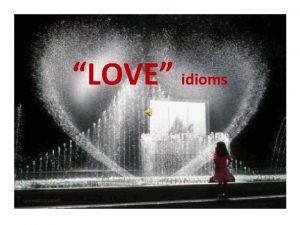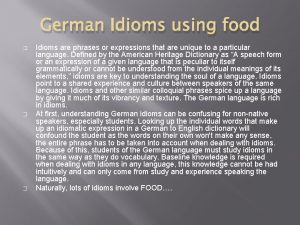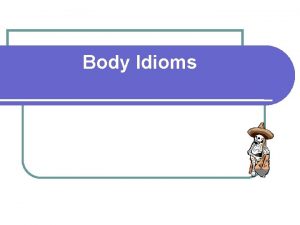Metaphors and idioms Chapters 3 4 Metaphors and
















- Slides: 16

Metaphors and idioms Chapters 3 -4

• Metaphors and idioms are types of figurative language used to create imagery and make writing more vivid. • These figures of speech are not taken for their literal meanings

Metaphors • In cognitive linguistics, conceptual metaphor, or cognitive metaphor, refers to the understanding of one idea, or conceptual domain, in terms of another. • Our ordinary conceptual system, in terms of which we both think and act, is fundamentally metaphoric in nature […] the essence of metaphor is understanding and experiencing one kind of thing in terms of another. (Lakoff/Johnson 1980: 3; 5, in Laviosa 2008: 32). • We employ concepts which are well-known to us to understand less familiar concepts. The well-known concepts often are of a more concrete nature than the less familiar ones, which may be abstract. Knowledge from one cognitive domain – the so-called source domain – is projected to another cognitive domain (i. e. , the target domain) • In this way great amounts of conventional conceptual metaphors are generated (conventional conceptual metaphor being the main category in the cognitive metaphor theory).

• An example of this is the understanding of ARGUMENT AS WAR reflected in our everyday language by a wide variety of expressions: • • • Your claims are indefensible. He attacked every weak point in my argument. His criticisms were right on target. I demolished his argument. I've never won an argument with him.

Conventional vs creative metaphors • A conventional metaphor is a familiar comparison that doesn't usually call attention to itself as a figure of speech. E. g. virus (IT) • A creative metaphor is an original comparison that calls attention to itself as a figure of speech. Also known as a poetic metaphor, literary metaphor, novel metaphor, and unconventional metaphor.

Creative metaphor • My fellow citizens, today we celebrate the mystery of American renewal. This ceremony is held in the depth of winter, but by the words we speak and the faces we show the world, we force the spring, a spring reborn in the world's oldest democracy that brings forth the vision and courage to reinvent America. When our Founders boldly declared America's independence to the world and our purposes to the Almighty, they knew that America, to endure, would have to change; not change for change's sake but change to preserve America's ideals: life, liberty, the pursuit of happiness. … • Today, a generation raised in the shadows of the cold war assumes new responsibilities in a world warmed by the sunshine of freedom but threatened still by ancient hatreds and new plagues.

• Source domain: seasons - spring/winter • Target domain: US politics – victory of Democrats over Republicans

• Alternative terminology VEHICLE for source domain, and TOPIC for target domain (Laviosa 2008: 31) eg. Madness is the vehicle commonly used to explain the topic of love in expressions such as “She drives me crazy”

Translation problems and strategies • Identifying conventional s opposed to creative metaphors • For conventional metaphors find, if possible, an equivalent metaphor in the target language • E. g. SADNESS IS COLOUR) – He was in a black mood > era di umor nero – I was feeling blue > no colour-based equivalent

idioms • A subtype of multi-word units, i. e. chunks of language conceived of as single lexical items rather than flexible combinations • their meaning cannot generally be inferred from the meaning of the single words;

A typology of idioms • i. referred to unreal events/conditions: – it’s raining cats and dogs, food for thought • i. that don’t follow grammatical rules: – to look daggers at somebody; to put paid to something; tha powers that be • i. With a simile-like structure: – as thick as two short planks; like water off a duck’s back • i. with both a literal and a figurative meaning: – To pull somebody’s leg; to take someone for a ride

Activity 4. 4. 1 round bat rain well bird soul times picture

Cucumber life (x 2) know down houses again/then reference wide pig

Strategies for translating idioms • Using an idiom of similar meaning and form – Jump down someone’s throat> saltargli alla gola • Using an idiom of similar meaning but different form – A storm in a tea cup > una tempesta in un bicchier d’acqua • Translating by paraphrase • Omission, if paraphrase is too complicated • Omission +compensation

What strategies would you use? • • When love is larger than life Kasia Boddy reviews The History of Love by Nicole Krauss. • • 12: 01 AM BST 30 May 2005 […] wonder, longing and imagination are what Krauss's stories and novels are all about. They are qualities that emerge in the aftermath of loss. One of Krauss's perennial concerns is how to survive loss; indeed, her exploration of love both in this novel and in her first, Man Walks Into a Room, is largely in relation to the past. […]Early in the story, to take just one example, Leo describes his pleasure at the movies, sitting close to the screen. "I can't tell you how happy it makes me to watch it up there, blown up. I would say larger than life, but I've never understood that expression. What is larger than life? To sit in the front row and look up at a beautiful girl's face two stories high and have the vibrations of her voice massaging your legs is to be reminded of the size of life. So I sit in the front row. If I leave with a crick in my neck and a fading hard-on it was a good seat. I'm not a dirty old man. I'm a man who wants to be as large as life. " •

(as) large as life • › lifesize; used as a way of describing a person you see, and are surprised to see: • I looked up from my newspaper and there he was, as large as life, Tim Trotter! • Cornish comedy legend Jethro is back, as large as life, and on tour in 2014 with his very own unique brand of irresistible West Country tales for a fun-filled night of adult comedy. (possible translations: sì, proprio lui / in carne ed ossa(? ) /a sorpresa) • Different from larger than life • Very striking or imposing; exaggerated; flamboyant, extravagant.
 Metaphor simile personification hyperbole
Metaphor simile personification hyperbole Hatchet lesson
Hatchet lesson Difference between idiom and proverb
Difference between idiom and proverb Biblical idioms and their meaning
Biblical idioms and their meaning I was so hungry that i even ate the plate
I was so hungry that i even ate the plate Cloud nine idiom
Cloud nine idiom Figures of speech and idioms
Figures of speech and idioms Friends n fun
Friends n fun Hyperbole alliteration
Hyperbole alliteration Idioms and phrases
Idioms and phrases Idiom for difficult task
Idiom for difficult task Hyperbole in catcher in the rye
Hyperbole in catcher in the rye Phrases with tener
Phrases with tener Memes with idioms
Memes with idioms Idioms in paragraph
Idioms in paragraph Idiom vs irony
Idiom vs irony This is a phrase in common use that cannot be understood
This is a phrase in common use that cannot be understood
